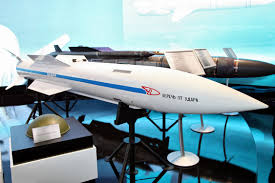R-37M Missile

- 13 Feb 2025
In News:
Russia has recently offered the R-37M missile, a state-of-the-art, long-range air-to-air missile, to India. This missile, one of the world’s most advanced, has the potential to transform India's aerial defense capabilities. The offer also comes with the opportunity for India to license the production of this missile domestically. However, the acquisition of such a potent weapon is raising tensions in the region, particularly with Pakistan, China, and Bangladesh, and has broader strategic implications.
Overview of R-37M Missile:
The R-37M, also known by its NATO reporting name AA-13 Axehead, is a hypersonic, long-range air-to-air missile developed by Russia.
It is designed to target high-value assets, such as AWACS (Airborne Warning and Control Systems), tanker aircraft, and other support platforms, beyond visual range (BVR).
Evolved from the R-33 missile, the R-37M significantly enhances air combat capabilities due to its range, speed, and precision.
- Speed and Range: The missile can travel at speeds of up to Mach 6 (approximately 7,400 km/h), enabling it to intercept fast-moving aerial threats. It has an operational range of 300-400 km (160-220 nautical miles), making it one of the longest-reaching air-to-air missiles.
- Weight: The missile weighs 510 kg, with a 60 kg warhead.
- Guidance System: It uses an advanced combination of inertial navigation with mid-course updates, active radar homing, and semi-active radar guidance for the terminal phase.
- Combat Advantage: The R-37M can target beyond visual range, enabling the launching aircraft to engage enemy targets while remaining outside the reach of enemy missiles.
Impact on the Indian Air Force (IAF):
The R-37M missile could replace the current R-77 missile used by India’s Sukhoi Su-30MKI fighter jets. This acquisition will bolster India's air defense by providing enhanced capabilities to intercept aerial threats at greater distances. Additionally, the offer to license the local production of the missile is a significant step toward strengthening India’s defense industry and reducing its dependence on foreign weapon systems. This move can also contribute to India's strategic autonomy in military engagements.
Strategic Implications for Pakistan:
Pakistan’s Air Force (PAF) primarily relies on F-16 fighter jets for its aerial superiority. However, these aircraft are vulnerable to interception beyond the Line of Control (LoC) by the R-37M, which has an engagement range of up to 400 kilometers. This could significantly alter Pakistan's defense posture, as its aircraft would be exposed to threats from Indian aircraft even before crossing the LoC.
Potential Effects on China:
China, which already possesses advanced air-to-air missiles such as the PL-15 and PL-21, will closely monitor India’s acquisition of the R-37M missile. While China is not directly threatened by the missile due to its own advanced defense systems, India’s missile capabilities could alter the balance of air superiority in the region. The acquisition could prompt China to accelerate the development of counter-hypersonic technologies, potentially altering the trajectory of military developments in the region.
Impact on Bangladesh:
Bangladesh, which shares friendly relations with India, could find itself caught in the strategic competition between India and Pakistan, despite its own military capabilities not directly challenging India. The regional military dynamics, influenced by India’s acquisition of advanced weapons like the R-37M, may push Bangladesh to enhance its defense capabilities, either through regional alliances or by procuring advanced defense technologies.
India-Russia Defense Relations:
India’s defense cooperation with Russia has been longstanding and substantial. Between 2015 and 2020, India’s defense imports from Russia were valued at approximately $10 billion, making Russia one of India’s largest defense suppliers. Around 70% of India's defense equipment is of Russian origin. Key joint defense projects include:
- BrahMos Missile: A joint venture to develop a supersonic cruise missile.
- S-400 Triumph: A $5.4 billion deal for five S-400 air defense systems.
- AK-203 Assault Rifles: A project for the local manufacturing of over 700,000 rifles.
- Military Exercises: India and Russia conduct joint military exercises, such as the INDRA (focused on counter-terrorism) and AVIAINDRA (aerial exercises between the Indian Air Force and Russian Aerospace Forces).
